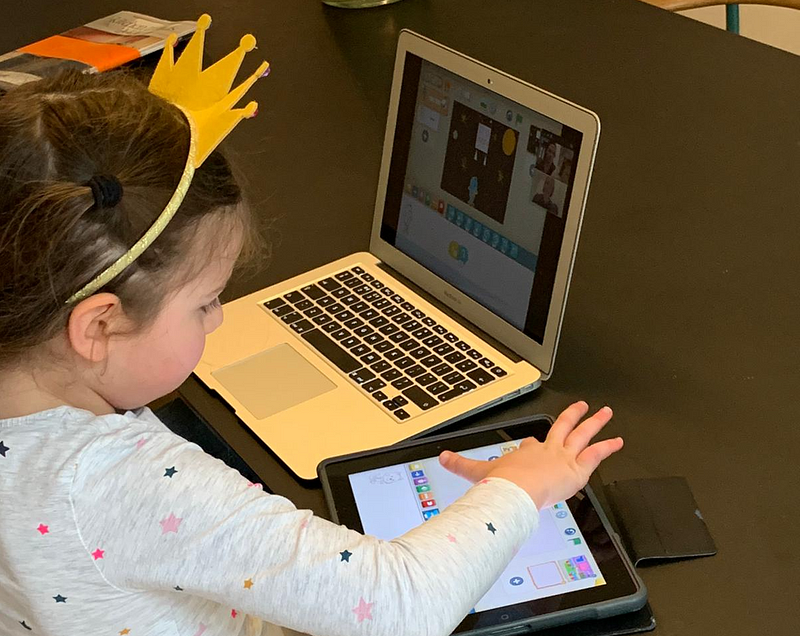Why we love learning online at blue{shift} education
The coronavirus pandemic has changed education - classes are going digital and learning is now being done remotely. Around the world, there's been a varied response from educational institutions to school closures and the move online. Some have been able to maintain their activity with minimum disruption, while for many other educators—the vast majority—it has been the case of doing the best they can under emergency conditions, hoping to adapt as they go.
As of 30th March my company - blue{shift} education, like UK schools and other educational institutions, moved all of its teaching online. For us, the move has been exciting and positive. As computing educators, our lessons have been highly successful in an online format, and we’ve seen a response from parents, teachers and students that has been highly enthusiastic.
As part of our transition to teaching online, we committed ourselves to researching and improving our remote learning as much as possible. This article highlights some of the interesting insights we've discovered as well as providing suggestions and solutions for educators.
Our research
Between 30 March and April 17, 2020, we taught 343 students in our online classes. Classes were small with a maximum of 6 students in each; they took place using Zoom. We used Padlet to share resources and communicate with parents and students. We used web-based coding platforms for programming (Scratch, Trinket, Repl, p5 and Minecraft). Children were aged 6 to 12 and each took courses consisting of 1 to 2 hour sessions every day for 5 days, meaning we delivered over 100 hours of unique online, interactive lessons.
We had students complete a survey at the end of every class to track their overall attitudes and pinpoint any frustrations. At the end of the week, students completed a survey regarding their attitudes towards online learning. Our findings are below.
Getting set up
A few basic guidelines established before class will ensure everyone arrives ready to learn.
Noise can be very disruptive even in small online classes.
We found that muting everyone to start with and having them raise their hand to speak was hugely productive.
“It would be better if less people talked at once because it is really hard to hear everyone.” — student, age 12
Students need to turn up on time and have their equipment ready to go.
One student struggling with set up will disrupt things for everyone else. We tell students who may have questions with setup to come early, rather than coming bang on time.
Basic digital literacy skills (or the lack thereof) can hold a class back .
In order to get the most out of online learning, students should understand how a browser works and how to access a website; they should know how to copy and paste links and how to drag and drop with a mouse. Ideally, they should have basic touch typing skills. One cannot assume that children even in upper KS2 have these skills.
For children 9 and under, we asked that parents were available for the first session to help set up their online learning software. After they are confident that their children can operate the software, they can always step back.
We have also found that children under 9 may be best accessing Zoom via a tablet and using any online software (eg. Scratch) via a laptop so that they don’t need to deal with having multiple windows open on a single screen.

Finally, we are developing a series of freely available materials that will help with basic digital literacy skills. For the moment, we have written an article on basic skills for children needed to be able to code online.
The majority of our students prefer online to in person classes
Our students have taken really well to learning with us online. More than half, 58% (!), said they preferred online learning to in person classes. There was no correlation with age (i.e. there was no increased preference for older learners).
“you can have people around the world(and you can chew gum in class)” — student, age 10
Students like working from home
Far and away the most popular reason for preferring online lessons was the ability to code from home. Students cited less distractions and the ability to concentrate better at home.
“I like it better because you are at home and you feel nicer at home.” — student, age 9
Small class sizes work in terms of student-teacher engagement
86% of students said our class sizes with a maximum of 6 were the perfect size.
 Having access to a teacher and coding from a single laptop works very well as a learning environment
Having access to a teacher and coding from a single laptop works very well as a learning environment
It seems that having everyone able to share screens and interact more easily in a digital sense made learning easier.
“There is more interaction with other people[sic] computer” — student, age 12
“You can have everything on the same thing at the same time and you can be in your own home” — student, age 8.
Having video, chat and shared files can make communication easier than in a traditional classroom
Some found communicating with teachers and peers easier — particularly as concerns sharing their code.
“I like it online because you get to see everyone and It’s easier to see the code that we’re supposed to do cause you can screen share it you can also talk to each other easier because you have them right in front of you”. — student, age 10
Understanding students’ frustrations with online learning allows us to address them better
Teacher engagement is a major concern for learners
The most common refrain heard from students with respect to frustrations they had learning online had to do with communication with the teacher.
Nearly 20% of students who preferred in person lessons, said they found it harder to get feedback from the teacher or get them to correct their work.
Clearly it’s important that teachers continually ask students how they’re getting on by asking for a ‘thumbs up’ from the class or ask them to raise their hand if they’re struggling. Screen sharing or sharing links to work is critical as well.
“[I prefer in person classes] because then the teacher can go around the class and show you how to do it in person.” — student, age 9.
Communicating online is more challenging for some learners.
While some preferred communication online, others found it easier to follow the class in-person. It’s important to be as aware of different learning styles in an online environment.
“I prefer in-person because explanations are clearer and a teacher is there to guide you.” --student, age 8.
Technical issues are a constant concern.
It’s important everyone has a decent internet connection and computer set up. We often ask students to sit closer to the router. Connection issues and glitchy software were concerns articulated by 8 different students; they can derail a students’ entire experience.
“you have to pray for the connection to be good”
This is just the beginning for online learning
We’ve seen our students making great gains and adapting to this new style of learning quite seamlessly. There is clearly some work to do with respect to network security and helping students to communicate and share work, though we’re really very excited by the possibilities.
We found our students often prefer learning online and feel quite secure learning within the comfort of their home (a comfortable environment does seem to be a favourable condition for learning). Students do feel some anxiety in terms of getting help from their teachers online which is something that needs to be addressed.
The blue{shift} top 5 pointers for online learning.
- Students should be punctual and ready to learn. If they have questions regarding their technical set up, they should ‘arrive’ to class before other students.
- Keep noise and distraction to a minimum. Mute everyone as a default.
- Spend the time learning basic digital literacy (it will save time in the long run). Even 10 year olds can struggle with copying and pasting links in order to share work. Our free guide to digital literacy (‘Getting ready to learn online’) is coming soon. Children 9 and under should have an adult nearby to ensure they’re on track; certainly for the first couple of lessons.
- Online learning is most enjoyable when students can get the feedback they need from teachers. Shared documents and learning environments mean that teachers can help students get unstuck when necessary.
- Small classes are optimal if there’s to be a lot of interaction between teacher and student; otherwise, the class becomes more of a webinar/lecture. Even in small classes of 6, teachers need to remind students to put up their hands if struggling and give a thumbs up to show that they’re progressing well.







 Having access to a teacher and coding from a single laptop works very well as a learning environment
Having access to a teacher and coding from a single laptop works very well as a learning environment